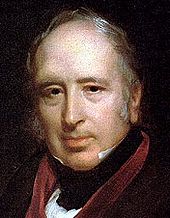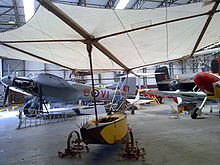George Cayley
Sir George Cayley, 6th Baronet , (born December 27, 1773 in Scarborough , Yorkshire , † December 15, 1857 in Brompton , west of Scarborough) was a British engineer who was one of the first to study the science of flight . He built the world's first glider as early as 1852, which was tested without a pilot.
Life
He was the eldest son of Sir Thomas Cayley, 5th Baronet (1732-1792), on whose death in 1792 he inherited the title of nobility Baronet , of Brompton in the County of York, created in 1661 in the Baronetage of England . From his 1795 marriage with Sarah Walker, he had four daughters and his son and heir as 7th Baronet, Digby Cayley (1807-1883).
He was accepted as a Fellow in the Royal Society . From 1832 to 1834 he was a Member of the House of Commons for the constituency of Scarborough .
Cayley glider
Cayley proved on the basis of intensive studies, against the belief of many, that it is impossible for humans to fly with a pair of “ wings strapped in ” with their own muscle power. A treatise he wrote on this subject in 1799 had a major influence on the further development of aviation . The Wright brothers also built their work on his findings .
In 1804 Cayley began to build large gliders that were already very similar to today's gliders. The gliders were monoplane with large front wings, smaller rear wings and horizontal stabilizers. He successfully tried out the gliders with animals as a crew.
In 1809, according to Cayley's own report in the Journal of Natural Philosophy, Chemistry and the Arts , Volume 24, there was a glider flight. In the report, he states that he has only tested the flight characteristics and safety precautions so far, but that he has not yet had the opportunity to fly with a crew. According to Richard Dee's research, Susan Sibbald reported in her memoir of a dinner with George Cayley in 1810, at which the latter reported that a boy had crashed and injured during a test flight in 1809.
In the middle of 1849 there was a tethered flight of a glider manned by a boy who was pulled against the wind with a rope by a ground crew. According to the sketches in Cayley's Egypt notebook , it was a glider with three superimposed wings and movable wings attached to the sides that were supposed to provide lift. This construction was mounted on a canoe-shaped frame with wheels.

In September 1852 Cayley published the article Sir George Cayley's Governable Parachutes ( Eng . Sir George Cayley's controllable parachutes) in Mechanics' Magazine , which contains the plans and descriptions for a single-wing glider. Cayley points out in his article that this aerial vehicle (dt. Aircraft) has been tested extensively without a pilot with ballast weighing one pound on the square feet of space .
Replica
The fact that there were no manned flights in the 40 years that followed until Otto Lilienthal's experiments casts doubt on Cayley's portrayal. On the other hand, the flying machine was reconstructed in 1973 according to original plans and successfully flown at the original launch site by the well-known English glider pilot Derek Piggot in a car tow, whereby Piggot was even able to control the glider. This at least proves the general suitability of the construction. Another, later replica flew in 2003. Allan McWhirter and Richard Branson were the pilots in this attempt .
Trivia
At the moment, without further confirmation, there remains a report that Cayley is said to have convinced his coachman in July 1853 to make himself available as a pilot (or rather: ballast). The glider is said to have been towed up a mountain in Brompton, from where it was then, with the coachman on board, pushed down the mountain by several workers until it took off and, after a 130 m flight, landed safely on a meadow. This would have been the first successful manned glider that has been handed down , already around 40 years before Otto Lilienthal .
The Cayley Glacier in Antarctica bears his name in his honor.
literature
- George Cayley: On aerial navigation. In: Journal of Natural Philosophy, Chemistry and the Arts. Volume 24.
- Richard Dee: The man who discovered flight. George Cayley and the first airplane. McClelland & Steward, Toronto 2007, ISBN 978-0-7710-2971-4 .
- Charles H. Gibbs-Smith : Sir George Cayley's Aeronautics , 1796-1855. Her Majesty's Stationery Office, London 1962.
- Susan Sibbald: The memoirs of Susan Sibbald 1783-1812. Kessinger Publishing. 2010.
- JAD Ackroyd: Sir George Cayley: The Invention of the Airplane near Scarborough at the Time of Trafalgar . In: Journal of Aeronautical History . tape 1 , 2011 ( Ackroyd: Sir George Cayley [PDF; accessed July 15, 2015]).
Web links
- Sir George Cayley, 6th Bt. On thepeerage.com
Individual evidence
- ↑ Sir George Cayley in Hansard (English)
- ↑ Susan Sibbald: The memoirs of Susan Sibbald 1783-1812.
- ↑ JAD Ackroyd: Sir George Cayley: ... p. 169 ff.
- ^ Richard Dee: The man who discovered flight. George Cayley and the first airplane. P. 238.
- ↑ George Cayley: Sir George Cayley's Governable Parachutes . In: Mechanics' Magazine . No. 1520 , September 25, 1852, p. 241 ff . ( online [accessed July 12, 2015]).
- ↑ John Ackroyd: Sir George Cayley - Inventor of the Airplane. In: Airplane Monthly. December 2003.
| predecessor | Office | successor |
|---|---|---|
| Thomas Cayley | Baronet (of Brompton) 1792-1857 |
Digby Cayley |
| personal data | |
|---|---|
| SURNAME | Cayley, George |
| ALTERNATIVE NAMES | Cayley, Sir George, 6th Baronet |
| BRIEF DESCRIPTION | British aviation pioneer, inventor of the science of flight |
| DATE OF BIRTH | December 27, 1773 |
| PLACE OF BIRTH | Scarborough , Yorkshire |
| DATE OF DEATH | December 15, 1857 |
| Place of death | Brompton |


